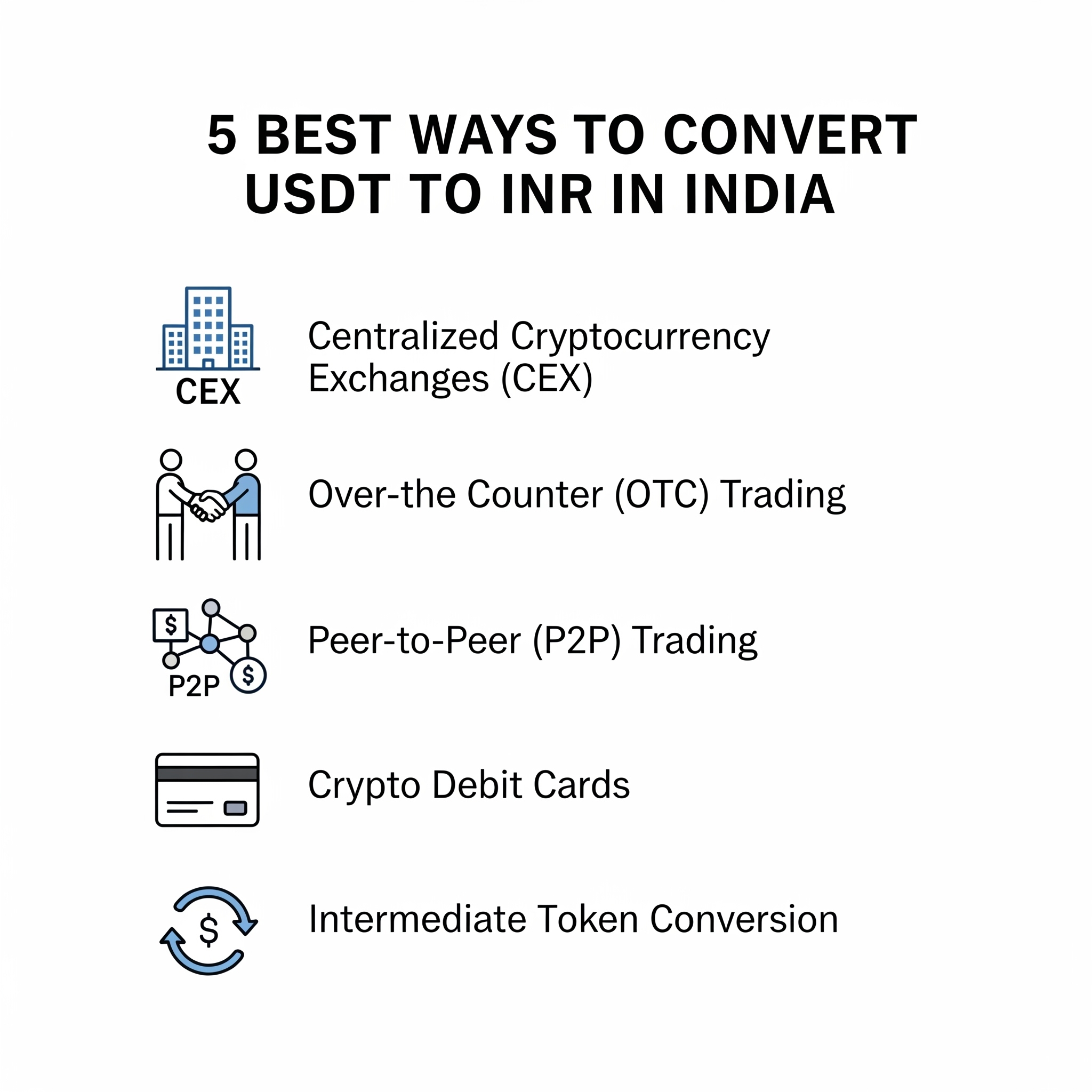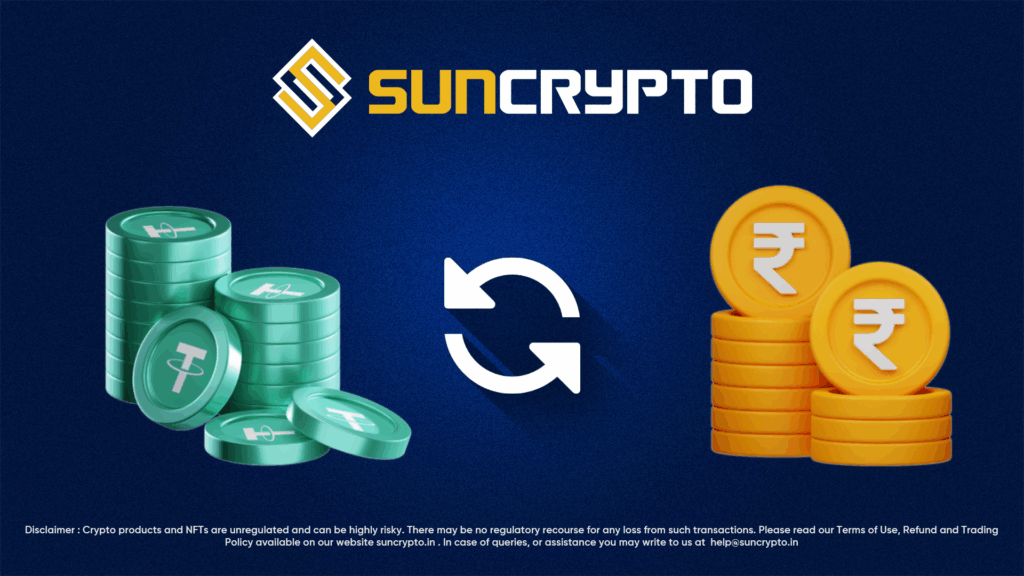Converting Tether (USDT) to Indian Rupees (INR) is a common need for cryptocurrency investors in India. While the process may seem complex, there are several reliable methods available. This guide will walk you through the most popular and efficient ways to convert USDT to INR with SunCrypto, allowing you to withdraw funds directly to your bank account.

Method 1: Centralized Cryptocurrency Exchanges (CEX)
SunCrypto is a CEX platform in India, and the platform convert USDT to INR. This is often the most straightforward and secure method for converting USDT to INR in India. A centralized exchange acts as a middleman, handling the entire transaction process.
How it works:
- Deposit USDT: Transfer your USDT from your crypto wallet to your account on a registered Indian exchange.
- Place a Sell Order: On the exchange’s trading platform, navigate to the USDT/INR trading pair. You can either place a limit order (where you specify a price you want to sell at) or a market order (to sell instantly at the current market price).
- Withdraw INR: Once your USDT is sold, the INR balance will be reflected in your exchange wallet. You can then initiate a withdrawal to your linked Indian bank account via a bank transfer method like IMPS, NEFT, or RTGS.
Pros:
- Simplicity: The process is user-friendly and well-guided, making it ideal for beginners.
- Security: Reputable exchanges have strong security protocols, and your funds are stored in a managed environment.
- Liquidity: These platforms have high trading volumes, ensuring your sell orders are filled quickly.
Cons:
- Withdrawal Fees: Exchanges typically charge a fee for withdrawing INR to your bank account.
- KYC Requirement: You must complete a Know Your Customer (KYC) verification process, which involves submitting personal documents.
Popular Exchanges for this method: SunCrypto, CoinSwitch, CoinDCX, and many more.
Method 2: Over-the-Counter (OTC) Trading
For individuals or institutions dealing with large volumes of USDT, OTC desk trading offer a personalized and efficient service and you can convert USDT to INR with SunCryto. OTC trades are conducted privately, outside of the public exchange order book.
How it works:
- Contact an OTC Desk: You get in touch with an OTC broker or desk that operates in India.
- Lock in a Price: The broker will quote you a price for your USDT, which you can lock in for a specific period.
- Settle the Trade: The trade is settled directly with the OTC desk, and the INR amount is transferred to your bank account.
Pros:
- High Liquidity: OTC desks can handle large volumes without causing significant price impact or slippage on public exchanges.
- Personalized Service: You get dedicated support and a one-on-one trading experience.
- Privacy: Transactions are private and do not appear on public order books.
Cons:
- Minimum Volume: OTC desks usually have a minimum transaction size, making them unsuitable for small investors.
- Trust: You must work with a reputable and trustworthy OTC service.
Method 3: Peer-to-Peer (P2P) Trading
P2P trading allows you to directly sell your USDT to another person in exchange for INR. The exchange platform acts as an escrow, holding the USDT until the buyer confirms payment, which adds a layer of security, but P2P might gets scary when there is entry of ransom money laundering happens via this method in India.
How it works:
- Post an Ad: On the exchange’s P2P platform, you post a sell order specifying the amount of USDT you want to sell, your desired price, and your preferred payment method (e.g., UPI, Bank Transfer).
- Match with a Buyer: A buyer will accept your order and send the agreed-upon INR amount directly to your bank account.
- Confirm Payment: Once you have verified that the INR has been credited to your bank account, you confirm the receipt of funds on the platform.
- Release USDT: The platform’s escrow service then automatically releases the USDT to the buyer’s wallet.
Pros:
- Direct Bank Transfer: You receive INR directly into your bank account from another individual.
- Competitive Prices: P2P allows you to negotiate or set your own price, often leading to better rates than a standard market order.
- Lower Fees: Many platforms offer P2P trading with zero fees.
Cons:
- Trust and Scams: While the escrow service adds security, you must be vigilant about confirming payments to avoid scams.
- Timing: The transaction time can vary depending on the buyer’s payment speed and bank transfer processing times.
Popular platforms for this method: Binance P2P and WazirX P2P are widely used in India.
Method 4: Crypto Debit Cards
While not a direct conversion method in the traditional sense, crypto debit cards offer an effective way to spend your USDT by instantly converting it to INR at the point of sale.
How it works:
- You load your crypto card with USDT, and when you make a purchase—either online or in a physical store—the card provider instantly converts the necessary amount of USDT into INR to complete the transaction.
- Some cards also allow for ATM withdrawals.
Pros:
- Provides a seamless way to use your crypto for everyday expenses without manual conversion. It can be more convenient than waiting for a bank withdrawal.
Cons:
- These cards may have conversion fees, and their availability for Indian residents can be limited due to regulatory uncertainties. You should carefully research the specific card’s policies and fees.
Available in India: While major global cards like Binance and Coinbase are not widely available in India, some domestic services like INRx Pay offer crypto-linked cards for instant crypto-to-INR conversions for spending.
Method 5: Intermediate Token Conversion
This method is a strategic approach to converting USDT to INR, often used when the direct USDT/INR trading pair has low liquidity or for specific arbitrage opportunities.
- How it works: You first sell your USDT for a highly liquid cryptocurrency like Bitcoin (BTC) or Ethereum (ETH). You then take the newly acquired BTC or ETH and sell it for INR on the same or a different exchange.
Pros:
- This method can be useful when you want to take advantage of better liquidity or a more favorable price on the BTC/INR or ETH/INR pair.
Cons:
- This involves two separate trades, meaning you will incur a trading fee for each transaction. It also exposes you to additional price volatility between the two steps.
Choosing the Right Method
The best method for you depends on your needs:
- For small, frequent transactions and ease of use, Centralized Exchanges are the ideal choice.
- For lower fees and direct bank transfers, P2P trading is a popular and effective alternative.
- For large volume transactions, an OTC desk provides a discreet and efficient solution.
Regardless of the method you choose, always prioritize using well-known, reputable platforms and enable all available security features, such as Two-Factor Authentication (2FA), to protect your assets.
Disclaimer: Crypto products and NFTs are unregulated and can be highly risky. There may be no regulatory recourse for any loss from such transactions.

